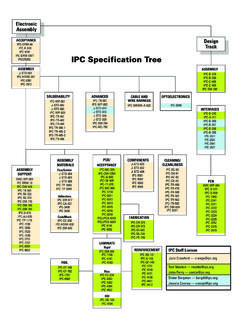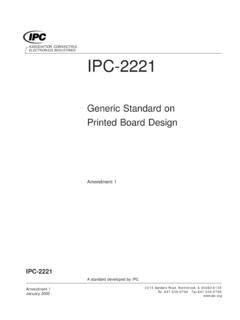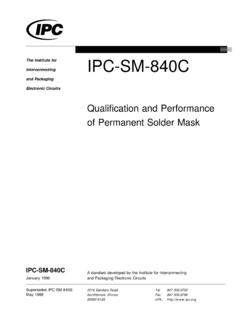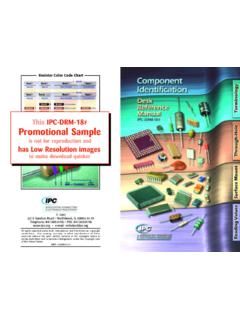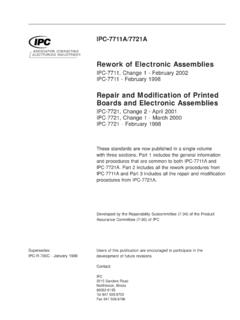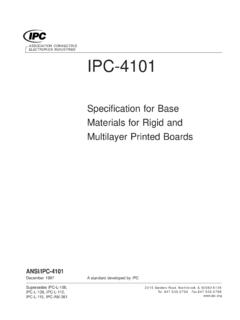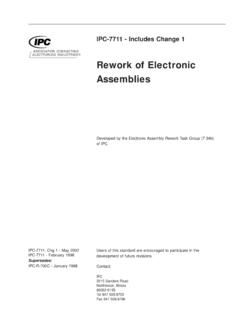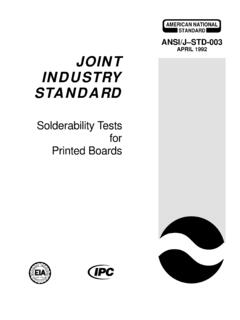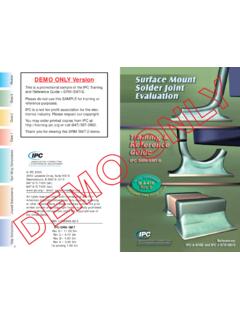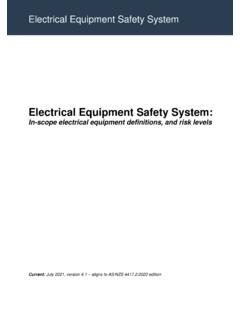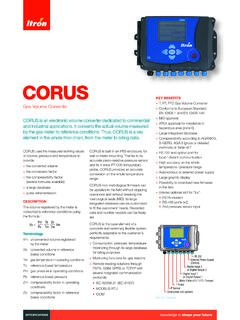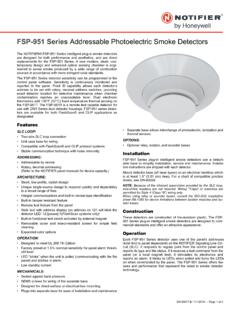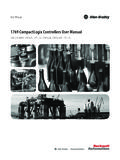Transcription of SMEMA - Dynamix Technology
1 Interface Standard SMEMA . Surface Mount Equtpment Manufacturers Association SMEMA Mechanical Equipment Interface Standard Introduction The SMEMA machine interface standards were developed to facilitate the interface of equipment used in the manufacture of surface-mounted printed circuit boards. This standard is for Mechanical interfaces. Purpose The purpose of this standard is to provide an equipment interface specification for single board transfer manufacturing systems of surface-mounted printed circuit boards. This specification provides the minimum requirement that conveyor-to-conveyor equipment must meet, and does not represent a complete specification for the equipment's interface.
2 Conformance to the standard may be achieved by the appropriate design of the equipment or by providing special adaptors which enable the equipment to meet the standard. Specifications The mechanical specifications that follow are for single board transfer systems with conveyor transports. These systems can be assembled next to each other without any interface hardware. The printed circuit board is assumed to move from left to right in the diaVr2n, E that follow; however, the same standard applies for systems when the board moves from right to left. An equipment manufacturer must clearly state the direction of board movement.
3 1.) Conveyor height Each machine must have the transport conveyor height adjustable from 37" to 38" from the floor to the bottom of the PC board. 2.) Conveyor width For equipment with an adjustable conveyor width, the front rail is fixed and the rear rail is adjustable. The range of adjustment will vary with the equipment manufacturer. 3.) Edge clearance The conveyor should require no more than 0. 187" of clear board space at the side edges. 4.) Tooling pins Tooling pins should be on the front edge of the board (next to the fixed transport rail). A recommended hole diameter is ".
4 (+.003, ). Distance from the edge is " + .010". 5.) Maximum gap The maximum gap between the in-line machine track ends is .375". 6.) Lead-in The minimum lead-in on the track ends of the conveyor is .1 25". 1. Interface Standard SMEMA Electrical Equipment Interface Standard Introduction The SMEN4A machine interface standards were developed to facilitate the interface of equipment used in the manufacture of surface-mounted printed circuit boards. This standard is for Electrical interfaces. Purpose The purpose of this standard is to provide an equipment specification for single board transfer manufacturing systems of surface-mounted printed circuit boards.
5 This specification provides the minimum requirement that the equipment must meet, and does not represent a complete specification for the equipment's interface. Conformance to the standard may be achieved by the appropriate design of the equipment or by providing special adaptors which enable the equipment to meet the standard. Figure 1. Electrical Interface Schematic 2. Interface Standard Specifications A machine-to-machine electrical interface is required to insure proper sequencing of PC boards. The interface is used for "Local" control and must operate independently of the cell controller.
6 1.) Electrical connections Each machine should be provided with a separate power connection and ground. Individual ON/OFF controls should also be provided. 2.) Grounding Each machine should have 1/4-20 earth ground stud on each side (left and right) of the machine. 3.) Inter-machine control To sequence boards properly from machine- to-machine, one or two signal lines will be used: "Board Not Available" and "Board Available.". 3. Interface Standard These signals are shown in Figure 2, and may be obtained using an optical isolator or a relay. The minimum requirements are to switch 3OV, 10 mA.
7 At 10 mA, the output "LOW" must not exceed volts. The logic is as follows: Board transfer occurs when Machine A has a board available (contact closed), and Machine B is not busy (contact closed). The signals can occur at anytime, but board transfer does not occur until both contacts are closed. The Board is Available signal from machine A will remain closed until the board has left Machine A. The Ready signal will remain closed until the board has arrived at Machine B. Board transfer cannot occur again until each signal opens for at least 50 ms. Optional: Once both Machine A and Machine B signals are closed, and the board has neither left A nor arrived at B, an error message will be generated.
8 Figure 2. Timing Diagram 4. Interface Standard SMEMA Connector Specifications Figure 4 SMEMA #001: Machine Connector Figure 4. SMEMA #002: Cable Connector About SMEMA . The Surface Mount Equipment Manufacturers Association ( SMEMA ) is a non-profit organization of companies manufacturing equipment or producing software for surface mount board production. Its objectives are to: promote standards for the interface and operation of equipment, provide users with the ability to select equipment with the assurance that the equipment will interface easily, advance SMT and promote its use and investigate areas where the association can act to the benefit of all member companies.
9 5.
